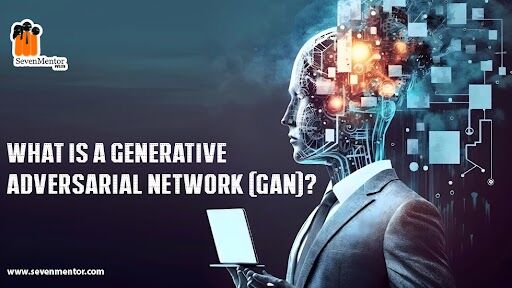What is a Generative Adversarial Network (GANs)?
Generative Adversarial Networks (GANs) have emerged as a transformative force in artificial intelligence, introducing a groundbreaking approach to data generation that transcends the traditional boundaries of machine learning. Conceived in 2014 by Ian Goodfellow and his colleagues, GANs have since sparked a revolution, particularly in the fields of computer vision, image generation, and creative Artificial Intelligence. This blog will embark on a comprehensive journey to unravel the intricacies of What is a Generative Adversarial Network (GANs)?, exploring their core components, applications, and the profound impact they have had on the landscape of AI.
The Essence of GANs:
At the heart of GANs lies a captivating concept: the adversarial training of two neural networks, the generator and the discriminator. This innovative approach creates a dynamic interplay where the generator’s primary mission is to craft data, such as images, that is virtually indistinguishable from real data. Simultaneously, the discriminator is tasked with distinguishing between authentic and generated data. This adversarial dance propels both networks to refine their capabilities continually, resulting in the creation of increasingly realistic data. Master the future with Artificial Intelligence Classes in Pune at SevenMentor.
Components of GANs:
1. Generator:
– The generator serves as the creative force within the GAN architecture. – Comprising layers of neurons, often arranged in a deep neural network, the generator learns to map random noise to realistic data.
– The ultimate objective is for the generator to produce data that is so convincingly real that the discriminator is unable to differentiate it from genuine data.
2. Discriminator:
– The discriminator acts as the gatekeeper, evaluating the authenticity of the input data and discerning between real and generated samples.
– Like the generator, the discriminator is a neural network but is specifically trained to enhance its ability to accurately classify data.
– The feedback loop between the generator and discriminator continues until a state of equilibrium is reached, where the generated data is of high quality.
For Free, Demo classes Call: 020-71177359
Registration Link: Click Here!
The Adversarial Process:
The training of GANs unfolds through a dynamic process of competition and collaboration:
1. Initialization:
– The generator begins with random noise as input, crafting initial generated data. – The discriminator is presented with a mix of real and generated data, initiating its learning process to differentiate between the two.
2. Adversarial Training:
– The generator strives to refine its data generation process, aiming to outsmart the discriminator.
– Simultaneously, the discriminator hones its ability to distinguish between real and generated data.
– This iterative process continues until a dynamic equilibrium is achieved.
3. Convergence:
– Ideally, the generator becomes so adept at creating realistic data that the discriminator struggles to differentiate between real and generated samples.
– At this point, the GAN has reached a state of convergence, and the generated data is of exceptionally high quality.
For Free, Demo classes Call: 020-71177359
Registration Link: Click Here!
Applications of GANs:
1. Image Generation:
– GANs have proven exceptional at generating high-resolution and realistic images. – This application is widely used in creating art, deepfakes, and enhancing the resolution of images.
2. Style Transfer:
– GANs facilitate the transfer of artistic styles between images, allowing the creation of images in the style of famous artists.
3. Data Augmentation:
– GANs contribute to machine learning by generating additional realistic data, augmenting training datasets, and enhancing model performance.
4. Image-to-Image Translation:
– GANs can convert images from one domain to another, such as turning satellite images into maps or black-and-white photos into color.
5. Super-Resolution Imaging:
– GANs are instrumental in enhancing the resolution of images, a valuable tool in medical imaging and satellite photography.
6. Anomaly Detection:
– GANs can be trained on normal data and identify anomalies by flagging data that deviates significantly from the learned normal patterns.
For Free, Demo classes Call: 020-71177359
Registration Link: Click Here!
Challenges and Considerations:
1. Mode Collapse:
– GANs may encounter mode collapse, where the generator produces limited diversity, generating only a subset of possible samples.
2. Training Instability:
– The training of GANs can be challenging, with issues such as vanishing gradients and oscillating behavior.
3. Ethical Concerns:
– The use of GANs in creating deepfakes and realistic synthetic content raises ethical concerns related to misinformation and privacy.
4. Evaluation Metrics:
– Assessing the quality of generated samples is subjective, and determining appropriate evaluation metrics remains an ongoing challenge.
Future Directions and Concluding Thoughts:
As Generative Adversarial Networks continue to evolve, ongoing research addresses challenges and expands their applications. Future developments may focus on improving stability during training, addressing ethical concerns, and exploring new domains of application.
Do watch our video on Artificial Intelligence to know more.
In conclusion, GANs stand as a testament to the boundless creativity that can be unleashed through adversarial training in the world of machine learning. They represent a groundbreaking paradigm in artificial intelligence, enabling machines not only to analyze data but also to create it. Whether in the realm of art, data augmentation, or image synthesis, GANs continue to unlock new possibilities, reshaping our understanding of what artificial intelligence can achieve. As they
journey into uncharted territories, GANs hold the promise of further transforming the landscape of AI and pushing the boundaries of human creativity.
Author:
Nishesh Gogia
Call the Trainer and Book your free demo Class For Artificial Intelligence Call now!!!
| SevenMentor Pvt Ltd.
© Copyright 2021 | SevenMentor Pvt Ltd.

